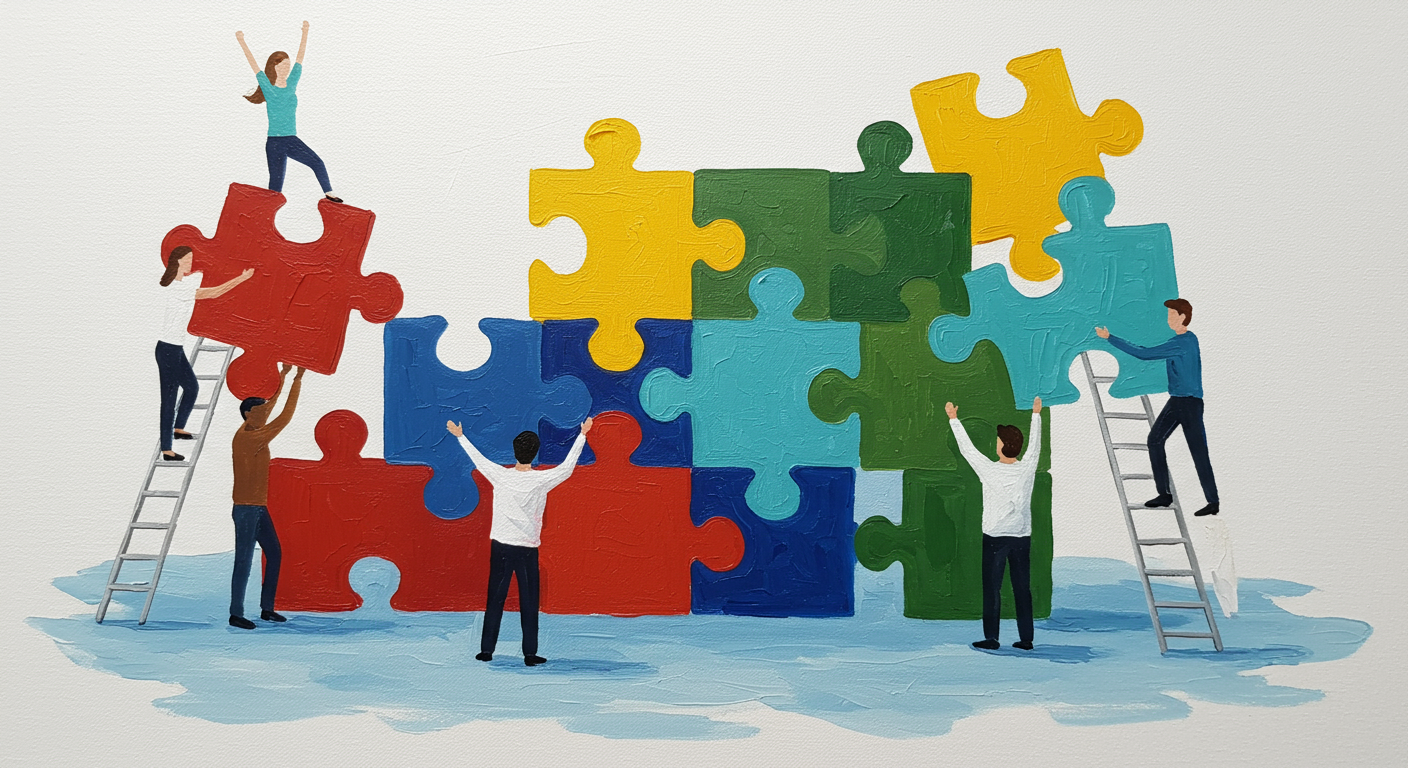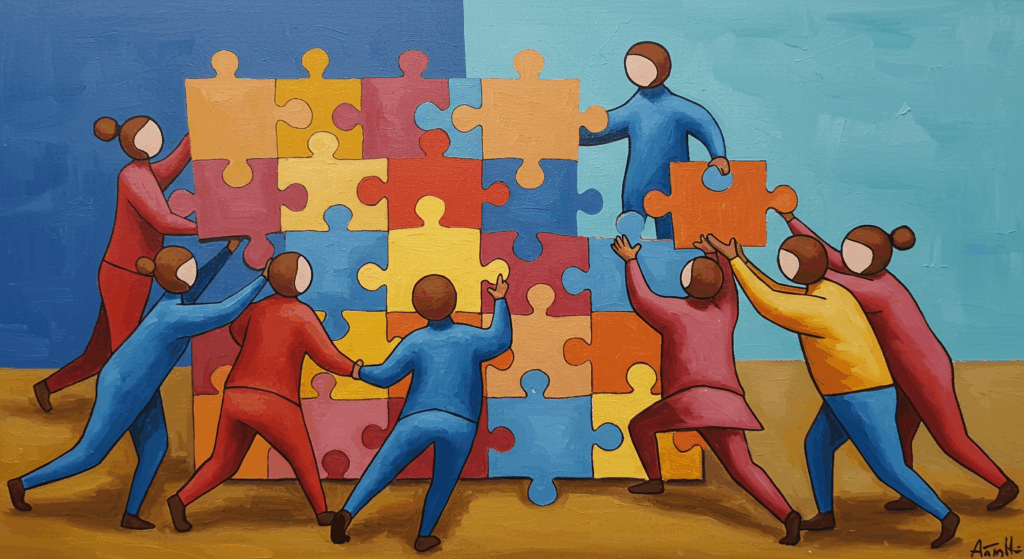Okay, be honest. When someone says “team builders,” what’s the first thing that pops into your head?
Is it that awkward office trust fall exercise where you’re low-key terrified your coworkers will let you hit the floor? Or maybe some cheesy icebreaker where you have to reveal your “spirit animal” and everyone says wolf or eagle (because, duh, who’s gonna admit they’re a goldfish)?
I get it. Team builders get a bad rap. They can sound super corporate-y, forced, or straight-up cringe. But — and hear me out — they actually work. Done right, team builders can take a random group of people and turn them into a squad that actually vibes, respects each other, and gets stuff done without burning out or plotting each other’s downfall.
And honestly? With how much of our lives we spend working (ugh, depressing but true), learning how to build good vibes through collaboration, teamwork, and leadership is not just helpful… it’s survival.
So, grab your iced coffee (or matcha latte if you’re in your “health era”), and let’s break down team builders in a way that doesn’t make you roll your eyes.
Why Team Builders Aren’t Just Corporate Fluff
Here’s the deal: humans are social creatures. Even if you’re introverted and would rather chill with Netflix than go to happy hour, you still benefit from connection. When you’re part of a group that actually works well together, life is just easier.
In a work setting, team builders give everyone a chance to connect beyond just deadlines and “pls see attached” emnails. They help break down walls, build trust, and spark collaboration.
Plus, let’s be real: no one wants to feel like they’re working with strangers every day. When people bond, they communicate better. And when communication improves, the whole team levels up. Less awkward silences, more “yo, I got your back” energy.
Collaboration: The Secret Sauce (But Not the Boring Kind)
Alright, so let’s talk about collaboration. Yeah, it’s a buzzword, but it’s kinda the backbone of team building. Collaboration isn’t just “working together.” It’s about figuring out how different brains, skills, and even quirks mesh into something better than the sum of its parts.
Think about your friend group. You’ve got the planner who organizes the road trip, the funny one who keeps the vibe alive, the practical one who brings snacks (MVP tbh), and the one who always knows the playlist. Alone, each is cool. Together? You’ve got a legendary weekend.
That’s how workplace collaboration works. A team builder helps highlight those strengths, show people how to lean into them, and makes sure no one feels like the forgotten “extra wheel.”
The Role of Teamwork (Spoiler: It’s Not Just “Playing Nice”)
Teamwork is thrown around so often it kinda loses meaning, but here’s the truth: good teamwork isn’t about everyone agreeing on everything. That’s impossible. It’s about figuring out how to disagree without making it messy, how to support each other without smothering, and how to keep moving forward even when things get tough.
Team builders create opportunities where people learn how to listen (actually listen, not just wait to talk), respect different perspectives, and realize that sharing ideas doesn’t mean losing credit.
And ngl, once you’ve experienced real teamwork — where everyone’s got their lane but also has each other’s backs — it feels like magic. Suddenly, deadlines feel less crushing, group projects stop being nightmares, and you actually look forward to working with people instead of dreading it.
Leadership and Team Builders: Not Just for “The Boss”
Here’s the spicy part: leadership isn’t just about the manager or the person with the fancy title. Leadership is about influence, not power. And team builders are sneaky good at revealing who has those natural leadership vibes.
Maybe it’s the quiet coworker who usually sits back but suddenly takes charge during a game and crushes it. Or the intern who organizes a brainstorming session better than anyone else. These moments matter.
Team builders give people a safe space to test their leadership muscles without the pressure of “oh no, if I mess up the whole company explodes.” It’s practice, but in a fun way. And honestly, we could all use more practice leading with empathy, communication, and trust.
Types of Team Builders That Don’t Suck
Okay, let’s address the elephant in the room: not all team builders are fun. Some are awkward, outdated, or just plain weird. But there are plenty that actually hit different and make people feel more connected. Here are a few vibes that usually work:
Icebreakers That Aren’t Cringe
Instead of “what’s your favorite color?” try something real, like “what show have you been bingeing?” or “what food could you eat every day without getting tired of it?”
(Answers like “pizza” are basic but valid. If someone says “celery sticks,” run.)
Creative Problem-Solving
Escape rooms, virtual puzzles, or even DIY hackathons. People bond like crazy when they’re all trying to figure something out under time pressure. Plus, you can spot natural leaders, quick thinkers, and even the patient mediators.
Physical Challenges (But Fun Ones)
Not everyone wants to climb a mountain, but simple activities like scavenger hunts or obstcle courses are great for energy and bonding. Pro tip: always include snacks at the finish line.
Casual Hangouts
Sometimes the best team builders aren’t structured. Grabbing tacos after work, having a game night, or even setting up a fantasy football (or Bachelor Nation lol) league can work wonders.
Remote Teams Need Builders Too
With so many of us working remotely or in hybrid setups, team builders look a little different now. It’s harder to vibe when you’re staring at little Zoom squares all day.
But that’s where virtual team builders come in. Online trivia games, meme-sharing channels, or even something as simple as a “photo of the week” Slack thread (pets always win btw) can help create those connections.
Because let’s be real — remote work is amazing for flexibility, but it can get lonely. A few intentional team builders can make it feel less like you’re stranded on your own island.
The Real Benefits You Might Not Notice Right Away
Okay, so aside from laughing with your coworkers or learning someone’s weird obsession with conspiracy theories, what’s the actual payoff? Team builders come with some sneaky-good perks:
- Better communication: People aren’t afraid to speak up because they’ve already built trust.
- Less drama: Misunderstandings happen less when people actually know each other.
- Higher creativity: When people feel safe, they share more ideas. And not just safe ideas, but bold ones.
- Improved leadership development: Team builders highlight who steps up and who supports.
- More job satisfaction: Honestly, when work feels like a squad instead of a solo grind, you’re just happier.
But… Do They Really Work for Everyone?
Here’s the honest part: team builders aren’t magic. If you’ve got toxic leadership, bad company culture, or people who refuse to engage, no game of Pictionary is gonna fix that. Team builders are like seasoning — they make a good base taste amazing, but they can’t fix rotten food.
Still, even in tough situations, the right kind of builder can open doors to better vibes. Sometimes, it just takes one shared laugh or unexpected bonding moment to soften walls.
How to Make Team Builders Not Awkward
So, if you’re in charge (or even if you’re not but want to suggest some ideas), here’s how to make team builders actually work:
- Keep it casual, not forced.
- Make sure activities fit your team’s vibe (don’t drag introverts into karaoke unless they volunteer).
- Rotate who plans or leads them — leadership practice for everyone.
- Always pair activities with food or chill tiime (trust me, snacks = connection).
- Reflect afterward: what worked? what didn’t? how did people feel?
Wrapping It Up: Team Builders Are More Than Just Games
So yeah, team builders might make you roll your eyes at first, but deep down, they’re powerful tools. They help us connect, strengthen collaboration, grow our teamwork skills, and practice leadership in ways that don’t feel like another boring meeting.
Think of it like this: team builders are the behind-the-scenes hacks that turn a group of coworkers into something that feels more like a band. Everyone has their instrument, their role, their solos — but together? You get a song that actually slaps.
So next time someone says “we’re doing a team builder,” instead of groaning, maybe give it a shot. Who knows? You might learn something new about yourself, your squad, or even that quiet coworker who secretly dominates at trivia night.
Your Turn
Alright, friend — now it’s your move. Whether you’re leading a team, joining one, or even just vibing in a group project at school, try out a little team building. Suggest a casual hangout, throw a fun game into the mix, or just break the ice in a new way.
Because at the end of the day, collaboration isn’t just a workplace buzzword. Teamwork is what makes the grind bearable. Leadership is what helps us grow. And team builders? They’re the tools that help it all click.
So go out there and make your team feel less like coworkers and more like allies. You’ve got this.









